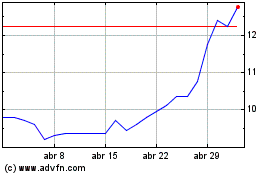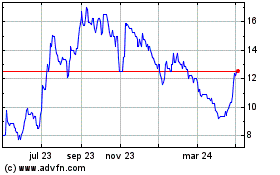TIDMRBW
RNS Number : 5080Z
Rainbow Rare Earths Limited
24 May 2021
Rainbow Rare Earths Limited
("Rainbow" or the "Company")
(LSE: RBW)
24 May 2021
INITIAL METALLURGICAL RESULTS FOR PHALABORWA PROJECT
Rainbow Rare Earths Ltd is pleased to provide an update on the
initial results of the ongoing metallurgical test work programme
for the Phalaborwa Project ("Phalaborwa" or the "Project") being
undertaken by ANSTO Minerals in Australia ("ANSTO").
-- Testwork has confirmed the phosphogypsum is amenable to
simple, direct, leaching with low cost sulphuric or hydrochloric
acid without pre-treatment:
o Initial recoveries of rare earths of greater than 70% have
been achieved within 24 hours, which will be improved through
further optimisations.
o It is expected that production of high value products (mixed
rare earth carbonate or separated rare earth oxides) will be
possible from the leach solution.
-- The phosphogypsum contains exceptionally low levels of
radioactive elements uranium and thorium when compared to other
rare earth projects:
o No radioactivity controls are expected to be required for the
shipment of the rare earth products.
o No expensive redeposition measures should be required for the
leached phosphogypsum residue.
-- The test work results to date support the expectations that a
simplified processing flow sheet can be developed and optimised
from the original Sasol flow sheet to recover the rare earths
without the high cost, energy and reagent intensive mining,
crushing, milling, primary beneficiation, cracking and
uranium/thorium removal costs associated with a typical rare earth
project.
-- The next phase of testing, currently in progress at ANSTO, is
focussed upon optimisation of leach recovery, acid consumption and
initial selective recovery of the rare earths from the leach
solution.
George Bennett, CEO, said: "We are excited by the initial highly
positive test work results received from ANSTO, which support our
view that Phalaborwa can be developed as a low capital intensity
project with operating costs near the bottom of the global rare
earth cost curve. The high initial recovery of rare earths reported
from the gypsum via a simple 24-hour acid leach process at ambient
temperature and pressure is a major benefit as we are essentially
dealing with a 'cracked chemical feed' that has occurred before the
gypsum residue was deposited. As we review further optimisation to
increase recovery of rare earth elements and reduce re-agent
consumption, we will carry out a thorough cost/benefit analysis to
ensure that each step increases the overall value of the
project.
These initial test work results confirm my belief that
Phalaborwa, by its nature, will probably be the fastest global rare
earth development project to get to the mixed rare earth carbonate
producing stage. We are targeting delivering production from
Phalaborwa in an accelerated time-frame which can only be achieved
because of the unique nature of the project with simple processing
requirements."
The first phase of work at ANSTO focused on testing various
leach lixiviants and conditions on a composite sample of material
sourced from auger drilling across the gypsum stacks. The composite
sample was constructed with 10 individual samples spatially
distributed to replicate the expected resource average grade with
respect to major and target elements.
Test work was performed utilising nitric acid, sulphuric acid
and hydrochloric acid as the key lixiviant based on historical work
completed on similar material. The sulphuric acid and hydrochloric
acid tests initially indicated good ambient temperature leach
recoveries and kinetics leaching virtually concluded within a 24
hour period recovering 70% of the rare earth elements present in
the sample. It is likely that sulphuric acid will be the lixiviant
of choice due to local availability, costs and materials of
construction as compared to hydrochloric acid.
Gamma analysis was also completed on the composite sample to
understand the presence of radioactive elements within the gypsum
stacks and the impact that may have on the processing and final
product. The analysis conducted to date shows that the overall
level of radioactive materials is low, with the phosphogypsum
having less than 1Bq/g of radionuclides present, which is in line
with the IAEA International guidelines for exemption from
regulations pertaining to radioactivity.
The test work to date has confirmed that the Phalaborwa tailings
are expected to be benign, negating the need to manage multiple
tailings facilities which adds increased costs for many global rare
earth projects. The concurrent rehabilitation of two historical
gypsum stacks reduces the environmental footprint in an
ecologically sensitive area.
Further work is planned to confirm the leach characteristic
variability of the stacks to support a preliminary economic
assessment for the Phalaborwa project. Further optimisation and
processing development work will then be undertaken prior to the
completion of a full feasibility study.
**ENDS**
For further information, please contact
Rainbow Rare George Bennett
Earths Ltd Company Pete Gardner +27 82 652 8526
SP Angel Corporate Ewan Leggat
Finance LLP Broker Charlie Bouverat +44 (0) 20 3470 0470
--------- ------------------- --------------------------------------
Flagstaff Strategic Tim Thompson +44 (0) 207 129 1474
and Investor Fergus Mellon rainbowrareearths@flagstaffcomms.com
Communications
------------------ --------------------------------------
Notes to Editors:
Rainbow's strategy is to become a globally-significant producer
of rare earth metals. NdPr are vital components of the strongest
permanent magnets used for the motors and turbines driving the
green technology revolution. Analysts are predicting demand for
magnet rare earth oxides will grow substantially over the coming
years, driven by increasing adoption of green technology, pushing
the overall market for NdPr into deficit.
The Phalaborwa Rare Earths Project, located in South Africa,
comprises approximately 35 million tonnes of gypsum tailings
stacked in unconsolidated dumps derived from historic phosphate
hard rock mining, containing rare earth elements with an initial
estimated average in situ grade of 0.45% TREO, based on previous
sampling campaigns, of which +/- 30% comprises high-value NdPr. The
rare earths are contained in chemical form in the gypsum dumps,
which is expected to deliver a higher-value rare earth carbonate,
with lower operating costs than a typical rare earth mineral
project.
The Company's Gakara Project in Burundi, which produces one of
the highest-grade concentrates in the world (typically 54% total
rare earths oxides ("TREO")) through ongoing trial mining
operations, is currently the only African producer of rare earths.
The Gakara basket is weighted heavily towards NdPr, which account
for over approximately 19.5% of the contained TREO and 85% of the
value of the concentrate.
This information is provided by RNS, the news service of the
London Stock Exchange. RNS is approved by the Financial Conduct
Authority to act as a Primary Information Provider in the United
Kingdom. Terms and conditions relating to the use and distribution
of this information may apply. For further information, please
contact rns@lseg.com or visit www.rns.com.
RNS may use your IP address to confirm compliance with the terms
and conditions, to analyse how you engage with the information
contained in this communication, and to share such analysis on an
anonymised basis with others as part of our commercial services.
For further information about how RNS and the London Stock Exchange
use the personal data you provide us, please see our Privacy
Policy.
END
MSCFLFVIEIIVFIL
(END) Dow Jones Newswires
May 24, 2021 02:00 ET (06:00 GMT)
Rainbow Rare Earths (LSE:RBW)
Gráfica de Acción Histórica
De Mar 2024 a Abr 2024

Rainbow Rare Earths (LSE:RBW)
Gráfica de Acción Histórica
De Abr 2023 a Abr 2024
